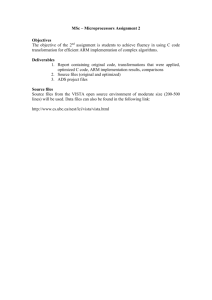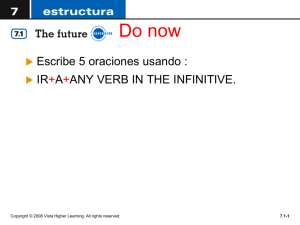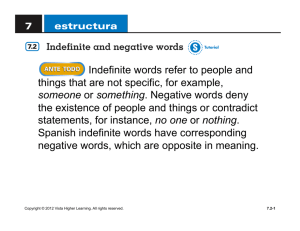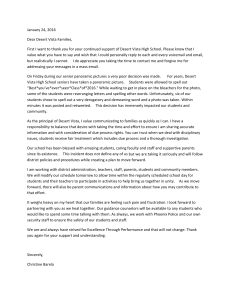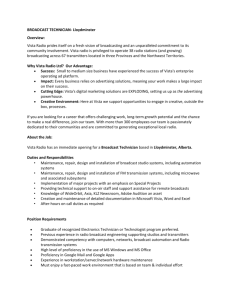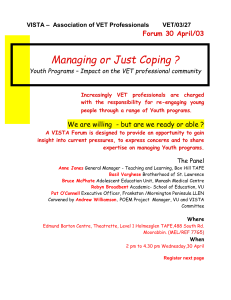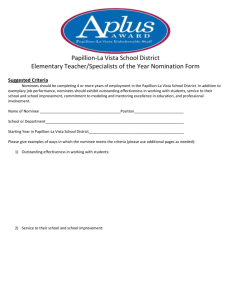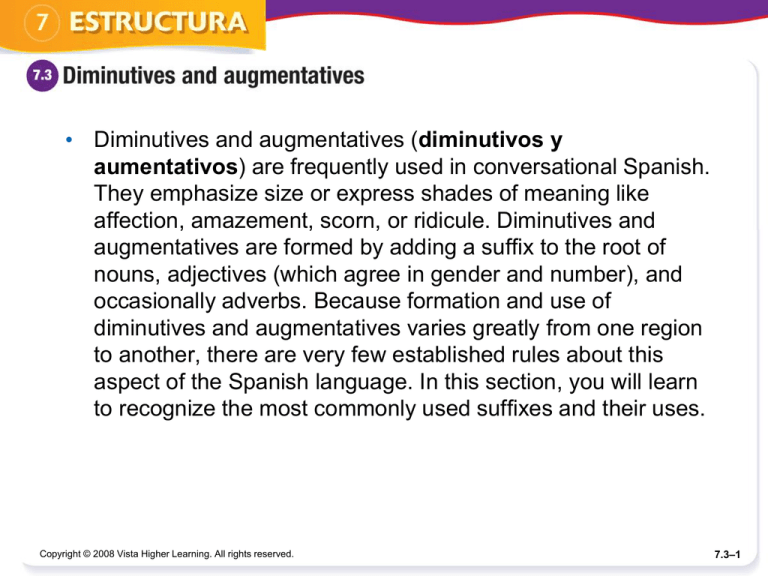
• Diminutives and augmentatives (diminutivos y
aumentativos) are frequently used in conversational Spanish.
They emphasize size or express shades of meaning like
affection, amazement, scorn, or ridicule. Diminutives and
augmentatives are formed by adding a suffix to the root of
nouns, adjectives (which agree in gender and number), and
occasionally adverbs. Because formation and use of
diminutives and augmentatives varies greatly from one region
to another, there are very few established rules about this
aspect of the Spanish language. In this section, you will learn
to recognize the most commonly used suffixes and their uses.
Copyright © 2008 Vista Higher Learning. All rights reserved.
7.3–1
Many root words take on new meanings when diminutive or
augmentative endings are added.ending in –s (singular or plural),
diminutive and augmentative endings precede the final –s.
pan
bread
panecillo
roll
pastel
cake
pastelito
pastry
cabeza
head
cabezón/cabezona
stubborn (person)
palabra
word
palabrota
swear word
Copyright © 2008 Vista Higher Learning. All rights reserved.
7.3–2
Diminutives
Copyright © 2008 Vista Higher Learning. All rights reserved.
7.3–3
• Here are the most common diminutive suffixes.
Pedrito, ¿me traes un cafecito con un panecillo?
Little Pedro, would you bring me a little cup of coffee with a roll?
Ahorita, abuelita, se los preparo rapidito.
Right away, Granny, I’ll have them ready in a jiffy.
Copyright © 2008 Vista Higher Learning. All rights reserved.
7.3–4
• Most words form the diminutive by adding –ito/a.
However, the suffix –illo/a is also common in some
regions. For words ending in vowels (except –e),
the last vowel is dropped before the suffix.
bajo ➞ bajito very short; very softly
libro ➞ librillo booklet
ahora ➞ ahorita right now; very soon
ventana ➞ ventanilla plane/car/bus
window
Miguel ➞ Miguelito Mikey
campana ➞ campanilla hand bell
Copyright © 2008 Vista Higher Learning. All rights reserved.
7.3–5
• Most words that end in –e, –n, or –r use the forms
–cito/a or –cillo/a. However, one-syllable words
often use –ecito/a or –ecillo/a.
hombre ➞ hombrecillo little man
pan ➞ panecillo roll
Carmen ➞ Carmencita little Carmen
flor ➞ florecita little flower
amor ➞ amorcito sweetheart
pez ➞ pececito little fish
Copyright © 2008 Vista Higher Learning. All rights reserved.
7.3–6
• Note these spelling changes.
chico ➞ chiquillo little boy; very small
agua ➞ agüita little bit of water
amigo ➞ amiguito little friend
luz ➞ lucecita little light
Copyright © 2008 Vista Higher Learning. All rights reserved.
7.3–7
For words ending in –s (singular or plural), diminutive and
augmentative endings precede the final –s.
Carlos Carlitos
besos besitos
Copyright © 2008 Vista Higher Learning. All rights reserved.
7.3–8
Augmentatives
• The most common augmentative suffixes are forms of
–ón/–ona, –ote/–ota, and –azo/–aza.
Copyright © 2008 Vista Higher Learning. All rights reserved.
7.3–9
Hijo, ¿por qué tienes ese chichonazo en la cabeza?
Son, how’d you get that huge bump on your head?
Jorge se gastó un dinerazo en una pantallota enorme, ¡sólo
para ver partidos de fútbol!
Jorge spent a ton of money on a humongous TV screen, just to
watch soccer games!
Copyright © 2008 Vista Higher Learning. All rights reserved.
7.3–10
• Most words form the augmentative by simply adding the
suffix to the word. For words ending in vowels, the final
vowel is usually dropped.
soltero ➞ solterón confirmed
bachelor
casa ➞ casona big house; mansion
grande ➞ grandote/a really big
palabra ➞ palabrota swear word
perro ➞ perrazo big, scary dog
manos ➞ manazas big hands
(clumsy)
Copyright © 2008 Vista Higher Learning. All rights reserved.
7.3–11
• You may notice a tendency to change a feminine word to
a masculine one when the suffix –ón is used, unless it
refers specifically to someone’s gender.
la silla ➞ el sillón armchair
la mujer ➞ la mujerona big woman
la mancha ➞ el manchón large stain
mimosa ➞ mimosona very
affectionate
Copyright © 2008 Vista Higher Learning. All rights reserved.
7.3–12
The letters t or et are occasionally added to the beginning of
augmentative endings.
guapa guapetona
golpe golpetazo
The masculine suffix –azo can also mean blow or shot.
flecha flechazo
arrow wound; love at first sight
rodilla rodillazo
a blow with the knee
Copyright © 2008 Vista Higher Learning. All rights reserved.
7.3–13
Regional use of diminutives and augmentatives
• Both diminutive and augmentative suffixes may vary
from one region to another and sometimes convey
different meanings or connotations.
¡Ay, qué perrito más lindo!
¡Ay, qué perrillo más feo!
Oh, what a cute little puppy!
Oh, what an ugly little mutt!
¡Qué hombretote!
¡Qué hombrón!
What a big man!
What a strong/brave man!
Copyright © 2008 Vista Higher Learning. All rights reserved.
7.3–14
• In regions where diminutives and augmentatives are
used heavily in conversational Spanish, double endings
are frequently used for additional emphasis
chico/a chiquito/a chiquitito/a
grande grandote/a grandotote
Copyright © 2008 Vista Higher Learning. All rights reserved.
7.3–15

